Table of Contents
Table of Contents
In today's digital era, where agility and efficiency are paramount, many organizations are transitioning from traditional Multi-Protocol Label Switching (MPLS) networks to the revolutionary Software-Defined Wide Area Network (SD-WAN). This migration allows businesses to embrace the flexibility, scalability, and cost-effectiveness of cloud-based applications and services. However, undertaking such a transformation comes with its challenges, especially when it comes to monitoring and ensuring a smooth transition.
Monitoring MPLS to SD-WAN migrations is one of the most common network monitoring use cases because of the growing dependence on SD-WAN networks to deliver traffic. When undertaking an MPLS to SD-WAN migration, it’s important to monitor network performance before, during, and after to ensure the migration goes smoothly. Keep reading to learn how!
In this blog post, we will delve into the world of MPLS to SD-WAN migrations and explore the essential monitoring strategies that can help businesses navigate this transition successfully. We will discuss the importance of monitoring during the migration process, the key metrics to track, and practical tips for effective monitoring. Whether you are in the midst of an ongoing migration or planning to embark on this journey, this guide will equip you with the knowledge and tools needed to ensure a smooth and successful transition.
So, if you're ready to dive into the intricacies of monitoring MPLS to SD-WAN migrations, let's explore the challenges, best practices, and monitoring solutions that will enable you to optimize your network performance and unlock the full potential of SD-WAN.
The shift from traditional MPLS (Multi-Protocol Label Switching) networks to SD-WAN (Software-Defined Wide Area Network) has gained significant momentum in the business world. But what drives organizations to embark on this migration journey?
Businesses are moving to cloud-based applications, which increases our reliance on the Internet to deliver WAN traffic. And MPLS (Multi-Protocol Label Switching) networks just can’t keep up. As a result, many businesses are migrating from MPLS networks to hybrid network or WAN architectures and SD-WAN technology.
In this section, we will explore the compelling reasons why businesses are migrating from MPLS to SD-WAN and the advantages they stand to gain.
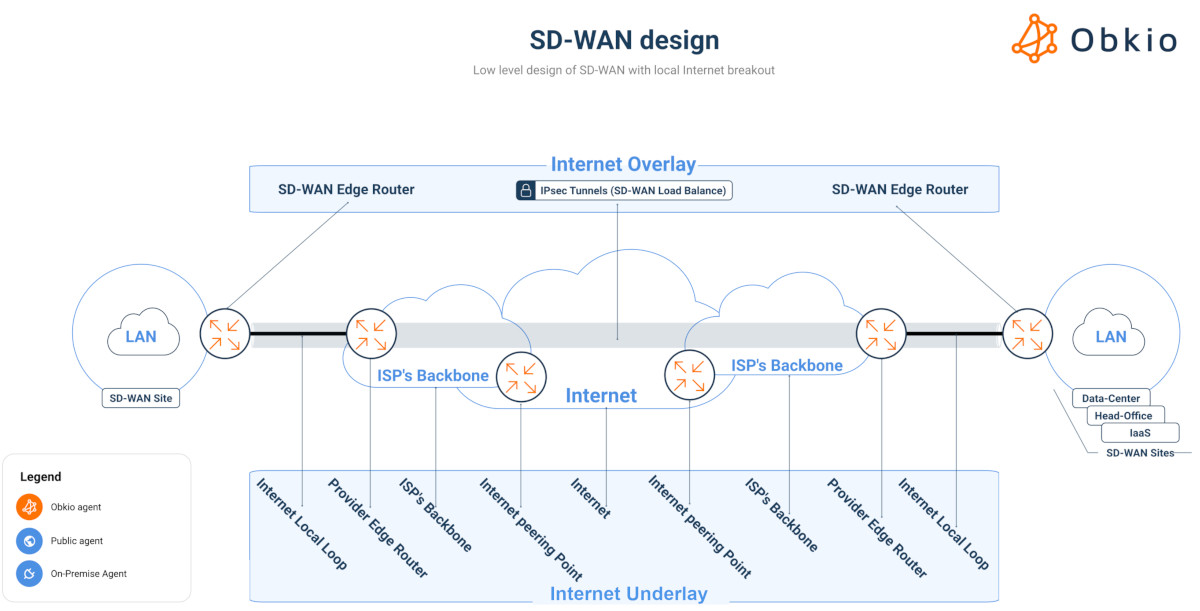

MPLS, which stands for Multi-Protocol Label Switching, is a widely used technology in networking that enables efficient and reliable data packet forwarding within a network. It is often deployed in Wide Area Networks (WANs) and Internet Service Provider (ISP) infrastructures to improve the performance and manageability of data traffic.
At its core, MPLS operates by adding a label or tag to each data packet as it enters the network. This label contains information that determines how the packet should be routed through the network. Unlike traditional IP-based routing, which examines the packet's destination IP address at each hop, MPLS labels allow for faster and more deterministic forwarding decisions.
The MPLS network consists of three key components:
- Label Edge Routers (LERs): These routers are responsible for assigning MPLS labels to incoming packets based on predetermined criteria, such as the packet's destination IP address. LERs are typically located at the edges or entry points of an MPLS network.
- Label Switch Routers (LSRs): These routers form the internal backbone of the MPLS network. LSRs examine the MPLS labels of incoming packets and use this information to make forwarding decisions. They forward packets based on the labels, rather than analyzing the packet's IP header at each hop, which enhances the efficiency of data forwarding.
- Label Distribution Protocol (LDP): LDP is a signaling protocol used by MPLS routers to exchange label information and establish label-switched paths. It ensures that all routers within the MPLS network have consistent knowledge of label assignments and can make accurate forwarding decisions.
SD-WAN, short for Software-Defined Wide Area Network, is a transformative networking approach that simplifies the management and operation of wide area networks. It combines the power of software-defined networking (SDN) and virtualization technologies to provide organizations with increased agility, flexibility, and control over their network infrastructure.
Unlike traditional WAN architectures that rely heavily on expensive and inflexible MPLS connections, SD-WAN leverages a combination of various network links, including broadband internet, 4G/5G, and MPLS, to establish secure and reliable connections between different locations, such as branch offices, data centers, and the cloud.
At the core of SD-WAN is centralized software control, which enables network administrators to define and enforce policies, prioritize application traffic, and dynamically route data based on real-time network conditions. This centralized control plane provides a holistic view of the network, allowing for simplified management and configuration.
- SD-WAN delivers higher bandwidth than MPLS networks because it relies on the Internet connection to deliver performance instead of private links. This also means it has better local access to the Internet.
- SD-WAN networks are flexible and can support the increasing use of SASE architectures and cloud-based applications, which MPLS networks cannot support.
- SD-WAN reduces costs by providing the flexibility to route data along the best available path, and can route data directly through the cloud.

More and more businesses are choosing to migrate from MPLS tp SD-WAN for a variey of reasons, but essentially, SD-WAN networks have a variety of benefits that allow them to better support the changing landscape of technology and networking for businesses. Here are a few reasons:
- Cost Savings: MPLS networks are known for their high operational costs, including expensive hardware, dedicated circuits, and long-term contracts. SD-WAN, on the other hand, offers cost-effective alternatives by leveraging readily available internet connections and enabling organizations to utilize lower-cost broadband links. This shift allows businesses to reduce their overall networking expenses while maintaining or even enhancing network performance.
- Enhanced Agility and Scalability: Traditional MPLS networks often lack the flexibility and scalability required to meet the evolving demands of modern businesses. SD-WAN provides dynamic and scalable network capabilities, allowing organizations to quickly adapt to changing requirements. With SD-WAN, businesses can easily add or remove network connections, allocate bandwidth based on application priorities, and scale their networks based on real-time needs.
- Optimized Performance: SD-WAN leverages intelligent traffic routing and path selection mechanisms to optimize network performance. It can dynamically route traffic over the most efficient path based on application-specific requirements, network conditions, and link quality. This ensures consistent application performance, reduces latency, and enhances user experience across geographically dispersed locations.
- Cloud Readiness: As more businesses embrace cloud-based applications and services, traditional MPLS networks may struggle to deliver optimal performance for these cloud workloads. SD-WAN is designed to seamlessly integrate with cloud environments, providing direct access to cloud applications and services while optimizing traffic flow and ensuring efficient utilization of network resources. This enables businesses to harness the full potential of cloud computing and enhance productivity.
- Business Continuity and Resilience: MPLS networks typically rely on a single carrier, making them vulnerable to network outages or disruptions. SD-WAN mitigates this risk by providing built-in redundancy and network failover capabilities. It can dynamically reroute traffic to alternate paths or backup connections, ensuring continuous connectivity and minimal downtime. This resilience is crucial for mission-critical applications and remote work scenarios.
Overall, SD-WAN empowers organizations to adapt to the evolving networking landscape, embrace digital transformation, and meet the increasing demands of modern business applications.
Explore the gladiators of WAN, MPLS vs. SD-WAN, strengths, weaknesses & ideal uses. Decide if SD-WAN networks or MPLS networks are right for your business.
Learn more

Monitoring MPLS to SD-WAN migrations is of utmost importance to ensure a smooth and successful transition from one network architecture to another. One mistake that businesses make when migrating from MPLS to SD-WAN is lacking visibility over their networks to:
- Optimize Network Performance Before & After the Migration: Monitoring allows organizations to closely track network performance before, during, and after the migration. It helps identify any performance bottlenecks, latency issues, or connectivity problems that may arise during the transition. By monitoring key performance indicators (KPIs) such as latency, packet loss, and throughput, organizations can proactively address issues, optimize configurations, and ensure a seamless user experience.
- Identify and Troubleshoot Issues During the Migration: Migrating from MPLS to SD-WAN involves a series of changes in network infrastructure, routing, and connectivity. Monitoring provides real-time visibility into network behavior, allowing IT teams to identify and troubleshoot any faults or errors that occur during the migration process. It enables quick diagnosis of problems, minimizing network downtime and reducing the impact on critical business operations.
- Plan for Resource and Capacity Management: Monitoring facilitates effective resource planning and capacity management during the migration process. By monitoring network utilization, bandwidth requirements, and traffic patterns, organizations can accurately allocate resources and ensure sufficient capacity to handle the increased demands of the SD-WAN environment. This prevents overprovisioning or underutilization of network resources, optimizing cost efficiency.
- Validate and Manage Changes When Migrating to SD-WAN: Migrating from MPLS to SD-WAN involves numerous configuration changes, such as policy updates, route modifications, and link provisioning. Monitoring allows organizations to validate and verify the correctness of these changes in real-time. It provides visibility into the impact of configuration adjustments, ensuring that the intended changes are implemented correctly and verifying the expected outcomes.
- Monitor User Experience and SLA Compliance: Monitoring plays a crucial role in maintaining a seamless user experience and meeting Service Level Agreement (SLA) commitments. By monitoring application performance, responsiveness, and end-user experience, organizations can ensure that the transition to SD-WAN does not result in degradation or disruption of critical applications. This enables businesses to meet SLA targets, deliver consistent service quality, and uphold customer satisfaction.
Keep reading to find out how to monitor your MPLS to SD-WAN migrations using end-to-end Network Monitoring - let's get started!
Monitoring MPLS to SD-WAN migrations requires a level of depth that can't be reached by most traditional monitoring tools. The migration process involves significant changes in network architecture, routing protocols, and traffic patterns, making it crucial to have comprehensive visibility into the entire network infrastructure.
During an MPLS to SD-WAN migration, you need to monitor:
- Before your migration (your MPLS network)
- After your migration (your SD-WAN network)
- Every decentralized network site
This is where specialized network monitoring solutions, like Obkio, come into play. Obkio is a network monitoring platform that provides advanced monitoring capabilities specifically designed for complex network environments, including MPLS to SD-WAN migrations. It leverages synthetic traffic generated by Network Monitoring Agents to continuously monitor end-to-end network performance.
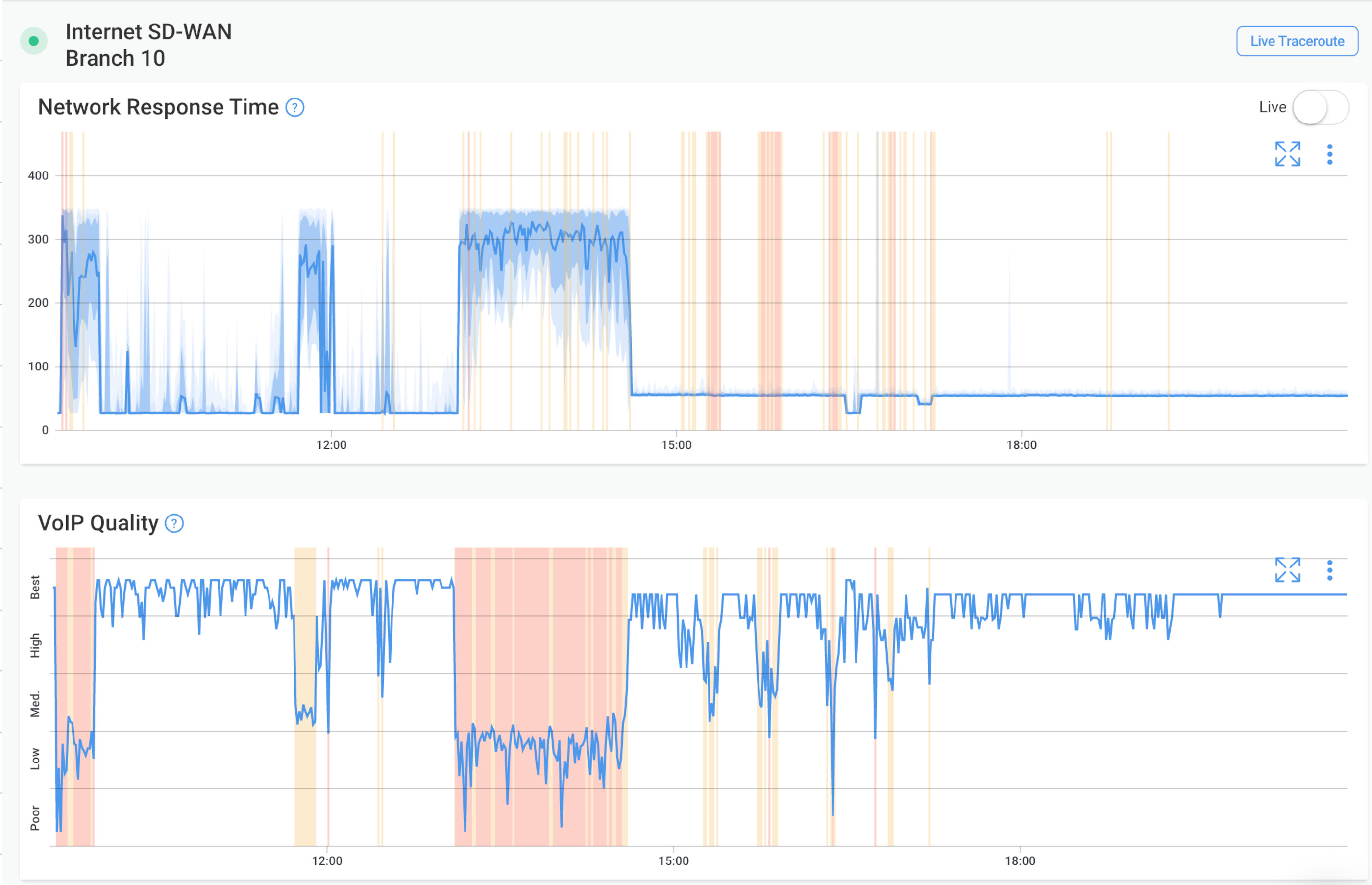
By using synthetic traffic, Obkio can simulate real-world network conditions and measure performance metrics in a controlled manner. This enables organizations to proactively identify potential issues, evaluate the impact of configuration changes, and ensure a smooth migration process. Additionally, the continuous monitoring provided by Obkio ensures that any performance degradation or anomalies can be quickly detected and addressed.

When performing an MPLS to SD-WAN migration, it’s important to deploy your monitoring solution before the migration, in your MPLS network, so you can compare the performance before and after the migration.
To do so, you need to deploy Monitoring Agents, which are a unique software that measure performance from one location (your computer or your office) up to the destination (another office, datacenter or clouds) to identify network problems. Obkio's Network Monitoring Agents are deployed strategically across the network, including at branch offices, data centers, and cloud environments. These agents collect data on network performance, application response times, and other relevant metrics, providing a comprehensive view of the network from different locations.
To monitor MPLS network performance prior to your migration, we recommend deploying:
- 1 Local Agent per network location: Data centers, remote offices etc.
- 1 Agents between network locations: Remote offices and your company’s headquarters, data centers or clouds
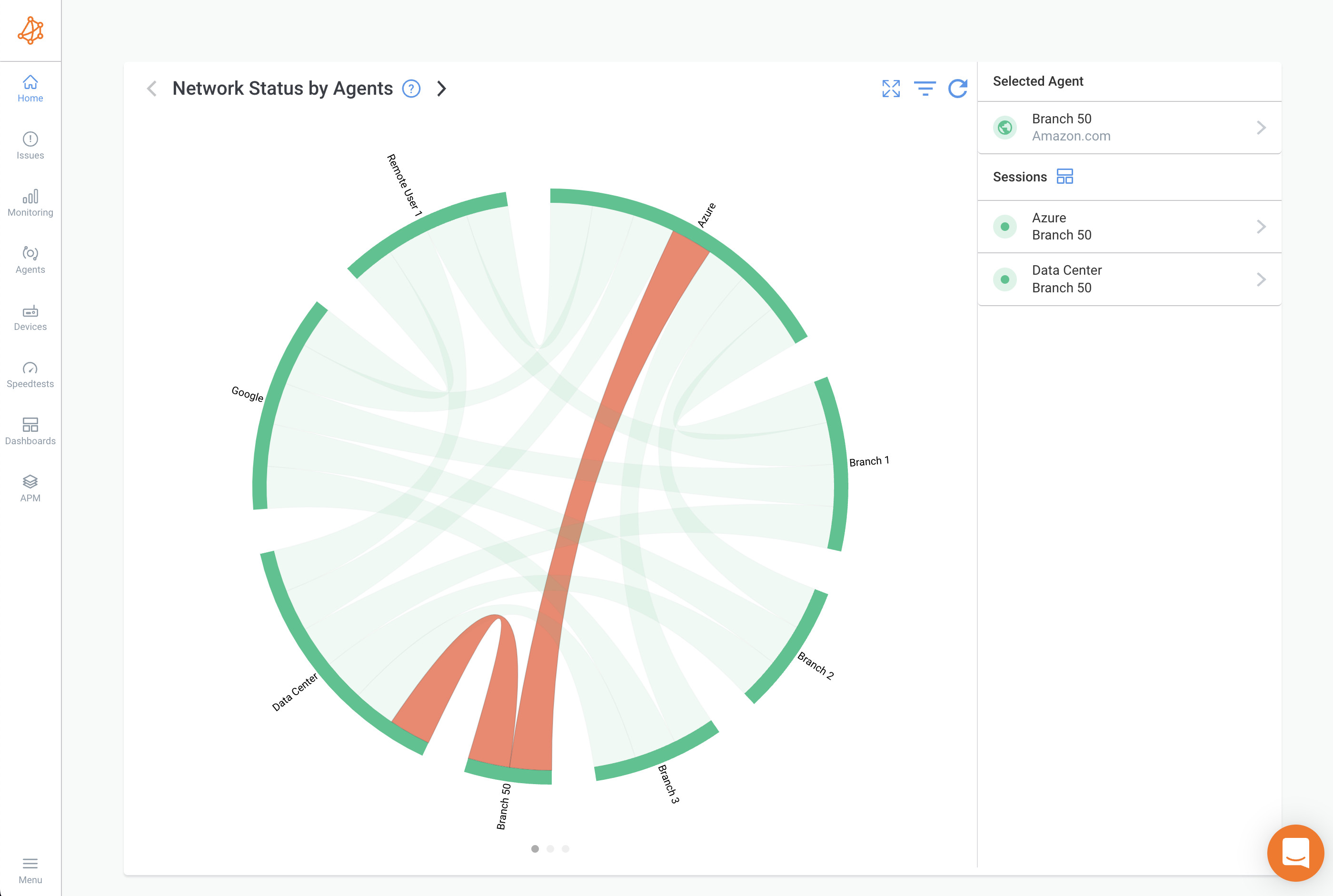
The Agents then create Monitoring Sessions by exchanging synthetic UDP packets between every 2 sets of Agents to measure performance metrics and raise network monitoring alerts for when network issues are detected.
At this point, you can identify network issues that could cause problems during the migration process.
If you do find anything suspicious, it’s important to troubleshoot before the migration.
Many people rely on SD-WAN networks, but they’re still prone to network issues. Learn about the 3 most common SD-WAN issues and how to solve them.
Learn more

During an MPLS to SD-WAN migration, several performance issues related to MPLS can arise and impact the migration process. It is crucial to be aware of these issues and monitor them closely to ensure a smooth transition. Here are some common MPLS performance issues that can affect an MPLS to SD-WAN migration:
- Latency: MPLS networks are designed to provide low-latency connections. However, latency issues can still occur, affecting application performance and user experience. High latency can result in delays in data transmission, causing slow application response times and negatively impacting real-time applications like video conferencing or VoIP (VoIP latency). Monitoring latency levels is essential to identify and address any latency spikes or inconsistencies that could impact the migration.
- Packet Loss: Packet loss occurs when network packets are dropped during transmission. MPLS networks typically have low packet loss rates, but occasional packet loss can still occur due to congestion, network errors, or misconfigurations. During the migration, it is crucial to monitor packet loss to identify any excessive or abnormal packet loss patterns that could affect the data integrity and application performance.
- Jitter: Jitter refers to the variation in packet delay, leading to inconsistent packet arrival times at the destination. In MPLS networks, jitter can occur due to congestion or network instability. It can impact real-time applications that require a consistent and predictable packet delivery rate, such as voice or video communication. Monitoring jitter helps ensure that the migration does not introduce additional jitter that could negatively impact application performance.
- Bandwidth Limitations: MPLS networks often have fixed bandwidth allocations for different traffic classes or service levels. In some cases, these bandwidth limitations may not align with the needs of specific applications or changing business requirements. During the migration, it is essential to monitor bandwidth utilization to identify any constraints or bottlenecks that may require adjustments or optimization in the SD-WAN environment.
- Quality of Service (QoS) Issues: MPLS networks commonly implement QoS mechanisms to prioritize specific types of traffic. However, misconfigurations or ineffective QoS policies can lead to suboptimal traffic prioritization, impacting critical applications or violating SLAs. Monitoring QoS parameters, such as prioritization policies and traffic classification, helps identify any QoS issues that may need to be addressed during the migration.
- Network Congestion: Network Congestion can occur in MPLS networks when there is an excessive demand for network resources, leading to performance degradation and packet loss. Monitoring network congestion levels helps identify congested links or nodes that could impact the migration process. It allows organizations to make informed decisions about traffic rerouting or provisioning additional network capacity as needed in the SD-WAN environment.
By closely monitoring these MPLS performance issues, organizations can gain insights into the behavior of the network, proactively identify and address potential challenges, and optimize the migration process to ensure a smooth transition to SD-WAN. Monitoring enables organizations to validate the performance improvements achieved with SD-WAN and ensure a seamless user experience during and after the migration.
Once you’ve deployed your issues and troubleshooted any issues, it’s time to migrate from your MPLS network to SD-WAN.
In the screenshot below, you can see an example of a branch office that migrated from a dedicated low-bandwidth MPLS connection to an SD-WAN service with two broadband connections.
There is a local monitoring agent in a branch office, with a monitoring session towards a monitoring agent located in a data center.
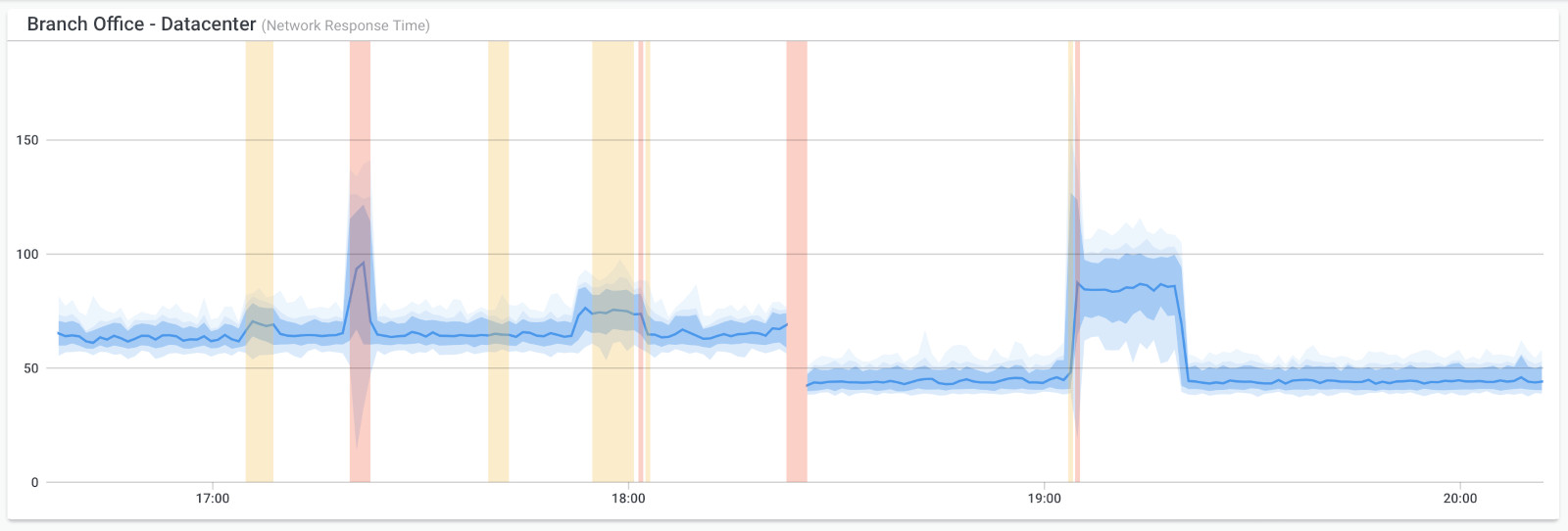
In this example, the branch office migrated from a dedicated low-bandwidth MPLS connection to an SD-WAN service with two brandband connections.
- The migration occurred in the middle of the graph (around 18:20).
- A few minutes later, around 19:00, the SD-WAN service switched from the primary ISP to the secondary ISP due to high packet loss for about 15 minutes.
- There is just a little bit of packet loss during the failover because it took a few seconds for the SD-WAN appliance to failover.
During an MPLS to SD-WAN migration, it is important to monitor several key aspects to ensure a successful transition. Here are the critical elements that should be monitored:
- Network Performance: Monitor network performance metrics such as latency, packet loss, jitter, and bandwidth utilization. This helps assess the impact of the migration on network performance and identify any bottlenecks or degradation that may arise during the transition.
- Application Performance: Monitor the performance of critical applications during the migration process. Measure application response times, throughput, and error rates to ensure that applications are functioning optimally in the new SD-WAN environment.
- Traffic Flows: Monitor the flow of traffic between different network locations, including branch offices, data centers, and the cloud. Track the volume and patterns of traffic to identify any abnormalities or deviations from the expected behavior.
- Routing and Path Selection: Monitor the routing and path selection mechanisms of the SD-WAN solution. Ensure that traffic is being properly routed over the desired paths based on policies and priorities. Verify that traffic is utilizing the appropriate network links, such as broadband or MPLS, as intended.
- Configuration Changes: Monitor configuration changes made during the migration process. Validate that changes are applied correctly and have the desired effect on network behavior. Track any deviations or errors in configuration to prevent potential issues.
- User Experience: Monitor end-user experience and satisfaction during the migration. Collect feedback on application performance, responsiveness, and usability to ensure that users are not adversely affected by the transition.
- SLA Compliance: Monitor the network's adherence to Service Level Agreements (SLAs). Measure and report on key performance indicators defined in the SLAs, such as uptime, latency, and [network availability. Ensure that the SD-WAN environment meets the agreed-upon service levels.
By monitoring these aspects during an MPLS to SD-WAN migration using Obkio's Network Monitoring Tool, organizations can gain valuable insights into the performance, security, and user experience of the network. This allows for proactive identification and resolution of issues, ensuring a smooth and successful transition to the SD-WAN architecture.
Once you've successfully migrated from your MPLS network to SD-WAN, it is crucial to evaluate and compare the performance of your new SD-WAN network to ensure it is delivering the promised benefits. By comparing the performance of both network architectures, you can assess the effectiveness of the migration and identify any areas that require further optimization or troubleshooting.
Obkio collects historical network performance data, so you can analyze, compare, and troubleshoot network performance from the past to understand the effect of the MPLS to SD-WAN migration on your network.
Comparing historical network performance data allows you to pinpoint any specific areas or time periods where the SD-WAN network may have outperformed or underperformed compared to MPLS. It helps you identify trends, patterns, and potential bottlenecks that may require further investigation or optimization.
Furthermore, Obkio's historical data analysis enables you to troubleshoot network performance issues that may have occurred during the migration process. By examining historical data, you can correlate network events, configuration changes, and performance anomalies to gain insights into the root causes of any performance issues. This information is invaluable for optimizing your SD-WAN deployment, adjusting policies, or fine-tuning the network for better performance.
The screenshot below shows a congestion problem on an MPLS network which was resolved thanks to the increase of bandwidth on the telecom link. Branch office 10 migrated from an MPLS connection to an SD-WAN service, which occurred at about 17:12 (where the tooltip appears).
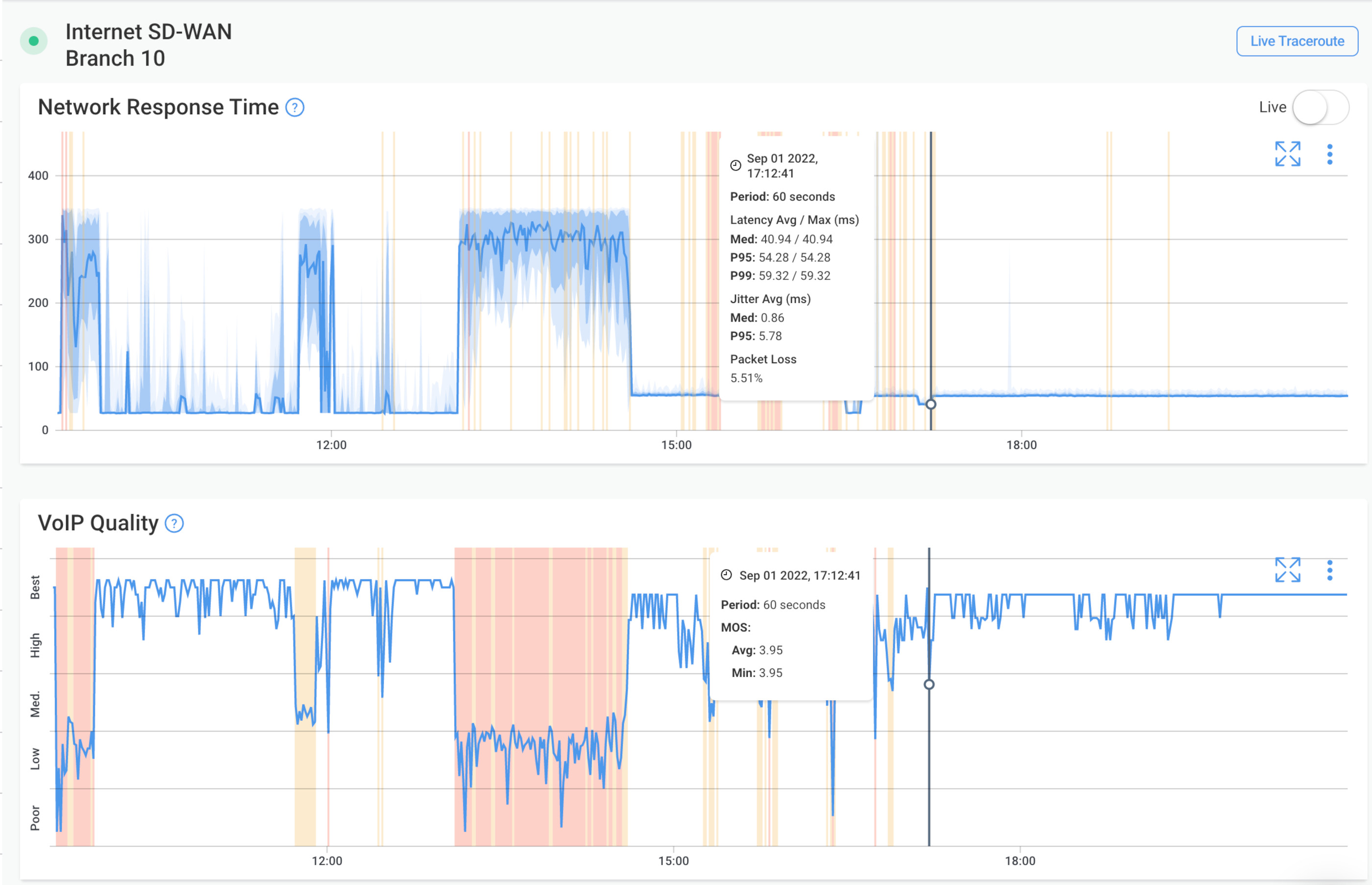

Obkio’s Network Response Time Graph and VoIP Quality Graph show a clear improvement in performance directly after the SD-WAN migration is completed.
After successfully completing the MPLS to SD-WAN migration, it is crucial to continue monitoring the performance of your network from both the end-user perspective and the underlay connections. This ongoing monitoring allows you to assess how well your new SD-WAN service is performing and ensure that it meets the desired objectives and expectations.
- Monitoring from the end-user perspective helps evaluate user experience and satisfaction with accessing applications and services over the SD-WAN network.
- Monitoring the underlay connections involves assessing the connectivity and performance of individual network links used by the SD-WAN solution.
- Continued monitoring allows for the proactive detection and resolution of performance degradation, bottlenecks, or connectivity issues that may arise post-migration.
- Monitoring both the end-user experience and the underlay connections helps identify the root causes of performance issues and take appropriate actions to rectify them.
- Ongoing monitoring ensures that the SD-WAN service delivers the desired performance, reliability, and user satisfaction in the long term.
- Performance monitoring provides valuable insights for network capacity planning and optimization, enabling informed decisions regarding network expansion or modifications.
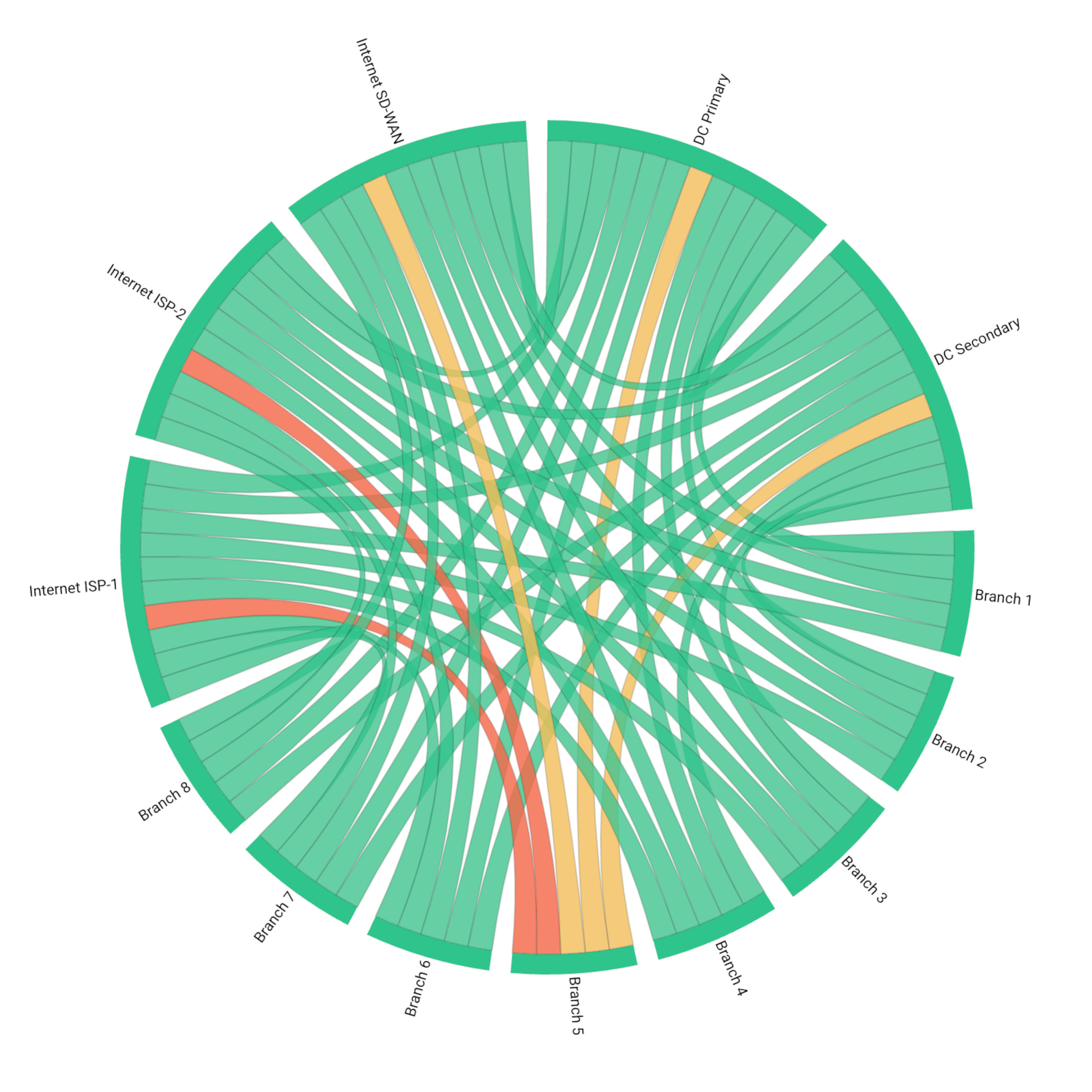
Continuous monitoring of SD-WAN performance from both the end-user perspective and the underlay connections with Obkio is essential after completing the MPLS to SD-WAN migration. This monitoring ensures that your SD-WAN service is performing optimally, meets user expectations, and allows for prompt detection and resolution of any performance issues.
You can learn more about that in our next article of the series on How to Monitor SD-WAN Networks.
Learn how to monitor SD-WAN networks with Network Monitoring to get complete visibility over your SD-WAN service and identify SD-WAN issues.
Learn more

Essentially, you can use Obkio's Network Monitoring tool to monitor end-to-end SD-WAN performance, including:
- The Internet
- Internet Local Loop
- Internet Provider’s Edge Router
- ISP Backbone
- ISP Peering Point
- Internet VPN IPSec between the site and ZScaler (Firewall As A Service)
- IPsec Tunnel from one site to another
- The LAN
- SD-WAN Edge
- Core & Distribution Switches
- Access Switches
- 80% of companies using SD-WAN experience performance issues on the last mile of the network. The last mile generally has the lowest speeds, the least route diversity and the most single points of failure.
- Firewall performance for managed Firewalls
- End-to-end performance for SASE networks
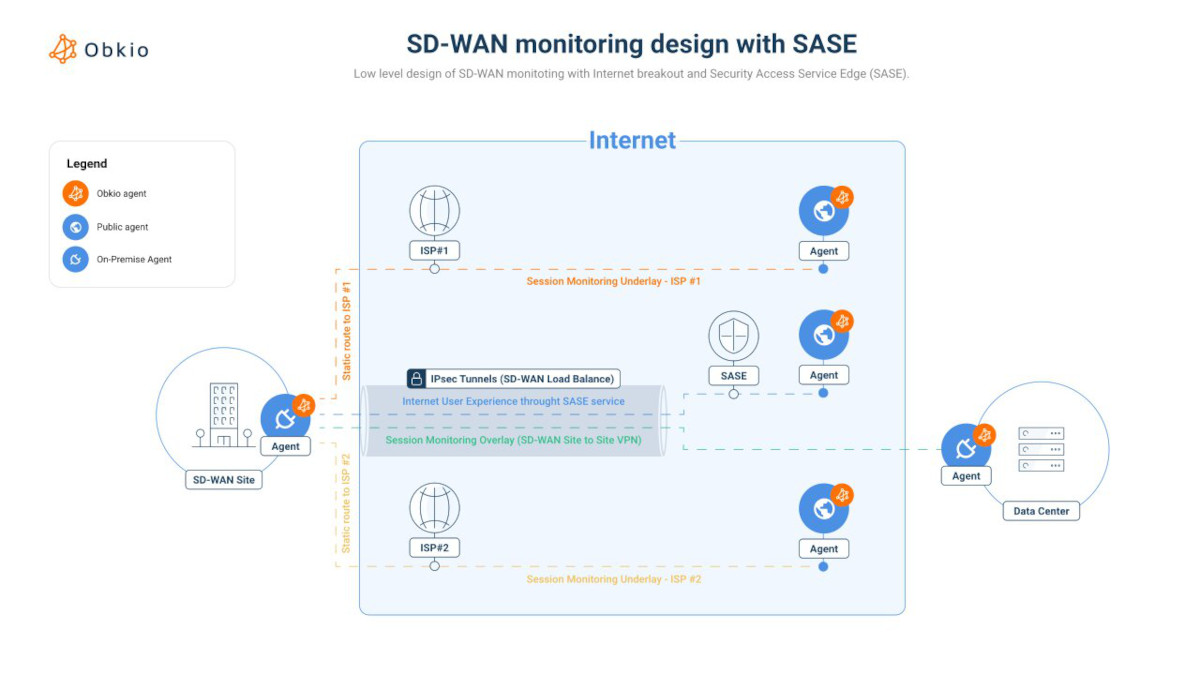
And there you have it! With this setup and you can monitor and ensure the success of your MPLS to SD-WAN migration. With such a big project to undertake, you can leave anything to chance. Let Obkio guide you!
Right before we leave you on your way to start your migration, we just want to make sure you have everything you need to get started. So to summarize this article make sure you're 100% ready, here's the only checklist you need to prepare for your MPLS to SD-WAN migraiton.
By following this checklist, you can ensure a well-prepared migration process that maximizes performance, enhances user experience, and provides the necessary insights to monitor, manage, and optimize your SD-WAN network effectively. Let's dive in:
- Document your current MPLS network architecture, including network links, devices, and their configurations.
- Identify critical applications and their traffic patterns.
- Determine the objectives and expected outcomes of the SD-WAN migration.
- Identify key performance metrics, SLAs, and security requirements.
- Research and assess different SD-WAN vendors based on your requirements.
- Consider factors such as scalability, security, management capabilities, and compatibility with Obkio monitoring.
- Design your SD-WAN network, considering branch office connectivity, data center connections, and cloud integration.
- Determine the types of network links (broadband, MPLS, Internet Multihoming, etc.) to be used and their bandwidth requirements.
- Install Obkio Monitoring Agents at strategic locations within your network infrastructure.
- Ensure Agents are deployed at branch offices, data centers, and other relevant network endpoints.
- Set up monitoring profiles within Obkio to capture key performance metrics (latency, packet loss, jitter, etc.) from the Agents.
- Define specific applications or IP addresses to monitor for performance evaluation. You can do this using Obkio's IP Monitoring.
- Collect baseline network performance data using Obkio before starting the migration to create a network baseline.
- Use this data to compare and assess performance improvements after the migration.
- Conduct pilot testing of the SD-WAN solution to ensure it meets performance and functionality requirements.
- Use Obkio to monitor and analyze network performance during the testing phase.
- Create a detailed plan for migrating from MPLS to SD-WAN, including a timeline and specific migration steps.
- Incorporate monitoring checkpoints using Obkio to assess performance at each stage of the migration.
- Execute the migration plan, ensuring proper configuration and connectivity of SD-WAN devices.
- Monitor network performance using Obkio during and after the migration to identify any issues.
- Monitor network performance using Obkio post-migration to ensure the SD-WAN service is performing as expected.
- Leverage Obkio's historical data to analyze, compare, and troubleshoot network performance over time.
- Use the insights gained from monitoring to optimize the SD-WAN environment and address any performance issues.
By following this checklist, you can effectively prepare for an MPLS to SD-WAN migration, while ensuring comprehensive monitoring with Obkio. This will help you assess performance, troubleshoot any issues, and ensure a successful transition to the new network architecture.


Continuously monitoring your network is the #1 way to prepare for an MPLS to SD-WAN migration.
Preparing for an MPLS to SD-WAN migration requires careful planning and consideration of various factors to ensure a smooth and successful transition. One crucial aspect of this preparation is implementing a comprehensive monitoring strategy that incorporates a powerful network monitoring tool like Obkio.
SD-WAN migration monitoring using Network Monitoring is an essential risk management tool to identify issues in your MPLS network that may affect your migration, track network health during, and compare performance after your MPLS to SD-WAN migration has been completed. Monitoring with Obkio allows organizations to gain valuable insights into network performance, diagnose issues, and optimize the SD-WAN environment for optimal performance.
After your migration, keep monitoring your SD-WAN network with Obkio to proactively identify SD-WAN issues!



























 Obkio Blog
Obkio Blog








